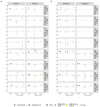How to account for behavioral states in step-selection analysis: a model comparison
- PMID: 38426131
- PMCID: PMC10903358
- DOI: 10.7717/peerj.16509
How to account for behavioral states in step-selection analysis: a model comparison
Abstract
Step-selection models are widely used to study animals' fine-scale habitat selection based on movement data. Resource preferences and movement patterns, however, often depend on the animal's unobserved behavioral states, such as resting or foraging. As this is ignored in standard (integrated) step-selection analyses (SSA, iSSA), different approaches have emerged to account for such states in the analysis. The performance of these approaches and the consequences of ignoring the states in step-selection analysis, however, have rarely been quantified. We evaluate the recent idea of combining iSSAs with hidden Markov models (HMMs), which allows for a joint estimation of the unobserved behavioral states and the associated state-dependent habitat selection. Besides theoretical considerations, we use an extensive simulation study and a case study on fine-scale interactions of simultaneously tracked bank voles (Myodes glareolus) to compare this HMM-iSSA empirically to both the standard and a widely used classification-based iSSA (i.e., a two-step approach based on a separate prior state classification). Moreover, to facilitate its use, we implemented the basic HMM-iSSA approach in the R package HMMiSSA available on GitHub.
Keywords: Animal movement; Fine-scale interactions; Habitat selection; Hidden Markov models; Integrated step-selection analysis; Markov-switching regression; Movement behavior; State-switching.
©2024 Pohle et al.
Conflict of interest statement
The authors declare that there are no competing interests.
Figures





Similar articles
-
Flexible hidden Markov models for behaviour-dependent habitat selection.Mov Ecol. 2023 Jun 3;11(1):30. doi: 10.1186/s40462-023-00392-3. Mov Ecol. 2023. PMID: 37270509 Free PMC article.
-
Objective classification of latent behavioral states in bio-logging data using multivariate-normal hidden Markov models.Ecol Appl. 2015 Jul;25(5):1244-58. doi: 10.1890/14-0862.1. Ecol Appl. 2015. PMID: 26485953
-
Accounting for behaviour in fine-scale habitat selection: A case study highlighting methodological intricacies.J Anim Ecol. 2023 Oct;92(10):1937-1953. doi: 10.1111/1365-2656.13984. Epub 2023 Jul 16. J Anim Ecol. 2023. PMID: 37454311
-
An introduction to statistical models used to characterize species-habitat associations with animal movement data.Mov Ecol. 2025 Apr 17;13(1):27. doi: 10.1186/s40462-025-00549-2. Mov Ecol. 2025. PMID: 40247418 Free PMC article. Review.
-
Uncovering ecological state dynamics with hidden Markov models.Ecol Lett. 2020 Dec;23(12):1878-1903. doi: 10.1111/ele.13610. Epub 2020 Oct 19. Ecol Lett. 2020. PMID: 33073921 Free PMC article. Review.
Cited by
-
Flexible hidden Markov models for behaviour-dependent habitat selection.Mov Ecol. 2023 Jun 3;11(1):30. doi: 10.1186/s40462-023-00392-3. Mov Ecol. 2023. PMID: 37270509 Free PMC article.
-
Considering landscape heterogeneity improves the inference of inter-individual interactions from movement data.Mov Ecol. 2025 Jun 12;13(1):41. doi: 10.1186/s40462-025-00567-0. Mov Ecol. 2025. PMID: 40506736 Free PMC article.
-
The 4th Dimension in Animal Movement: The Effect of Temporal Resolution and Landscape Configuration in Habitat-Selection Analyses.Ecol Evol. 2025 May 12;15(5):e71434. doi: 10.1002/ece3.71434. eCollection 2025 May. Ecol Evol. 2025. PMID: 40357139 Free PMC article.
-
Methods for implementing integrated step-selection functions with incomplete data.Mov Ecol. 2024 May 9;12(1):37. doi: 10.1186/s40462-024-00476-8. Mov Ecol. 2024. PMID: 38725084 Free PMC article.
References
-
- Adam T, Griffiths CA, Leos-Barajas V, Meese EN, Lowe CG, Blackwell PG, Righton D, Langrock R. Joint modelling of multi-scale animal movement data using hierarchical hidden Markov models. Methods in Ecology and Evolution. 2019;10(9):1536–1550. doi: 10.1111/2041-210X.13241. - DOI
-
- Arce Guillen R, Lindgren F, Muff S, Glass TW, Breed GA, Schlägel UE. Accounting for unobserved spatial variation in step selection analyses of animal movement via spatial random effects. Methods in Ecology and Evolution. 2023;14(10):2639–2653. doi: 10.1111/2041-210X.14208. - DOI
-
- Avgar T, Potts JR, Lewis MA, Boyce MS. Integrated step selection analysis: bridging the gap between resource selection and animal movement. Methods in Ecology and Evolution. 2016;7(5):619–630. doi: 10.1111/2041-210X.12528. - DOI
-
- Burnham KP, Anderson DR. Model selection and multimodel inference: a practical information-theoretical approach. 2nd Springer; New York: 2002.
-
- Celeux G, Durand J-B. Selecting hidden Markov model state number with cross-validated likelihood. Computational Statistics. 2008;23(4):541–564. doi: 10.1007/s00180-007-0097-1. - DOI
MeSH terms
Associated data
LinkOut - more resources
Full Text Sources
Research Materials

